#National Museum of Anthropology
Text
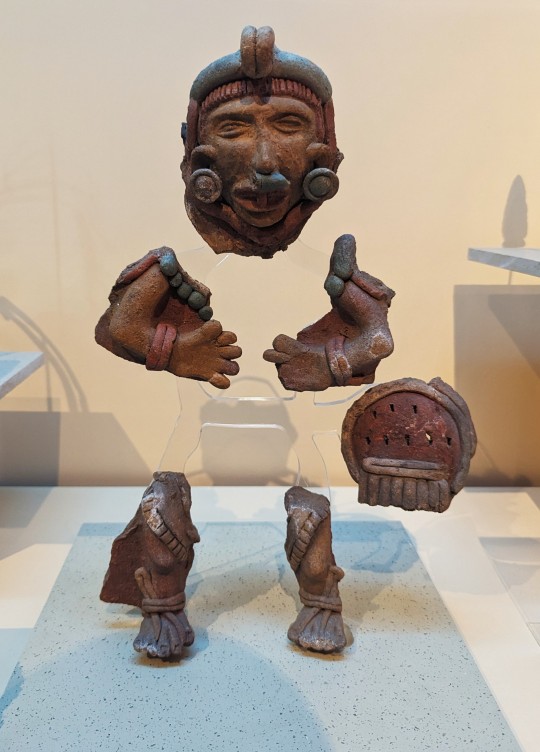
Clay Figure of Warrior from Xochicalco, Mexico dated between 650 - 900 on display at the National Museum of Anthropology in Mexico City, Mexico
Photographs taken by myself 2023
#military history#art#archaeology#fashion#armour#mexico#mexican#medieval#national museum of anthropology#mexico city
134 notes
·
View notes
Text
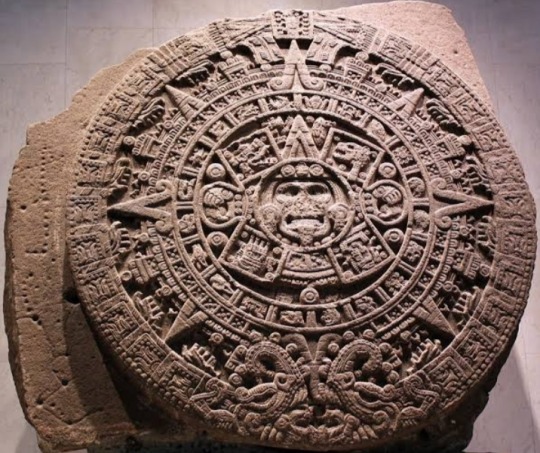
Aztec Sun Stone (Calendar Stone) depicts five consecutive worlds of the sun from Aztec mythology.
Stone is not, therefore, in any sense a functioning calendar, but rather it is an elaborately carved solar disk, which for Aztecs and other Mesoamerican cultures represented rulership.
At the top of the stone is a date glyph (13 reed), which represents both beginning of the present sun, fifth and final one according to mythology, and the actual date 1427 CE, thereby legitimizing the rule of Itzcoatl (who took power in that year) and creating a bond between divine and mankind.
Stone was discovered in December 1790 CE in central plaza of Mexico City. It now resides in National Museum of Anthropology in that city.
The richly carved basalt stone was once a part of the architectural complex of Temple Mayor and measures 3.58m in diameter, is 98cm thick, and weighs 25 tons.
Stone would originally have been laid flat on the ground and possibly anointed with blood sacrifices.
When it was discovered, the stone was lying flat and upside down, perhaps in an attempt to prevent the final cataclysm — fall of fifth and final sun as Aztec world fell apart following the attack from Old World.
At the centre of the stone is a representation of either the sun god Tonatiuh (the Day Sun) or Yohualtonatiuh (the Night Sun) or the primordial earth monster Tlaltecuhtli, in the latter case representing the final destruction of the world when the fifth sun fell to earth.
The tongue is perhaps also a sacrificial knife and, sticking out, it suggests a thirst for blood and sacrifice.
Around the central face at four points are other four suns, which successively replaced each other after gods Quetzalcoatl and Tezcatlipoca struggled for control of the cosmos until the era of the fifth sun was reached.
The suns are known by the day name on which their final destruction occurred.
Beginning from the top right, there is the first sun Nahui Ocelotl (4 - Jaguar), top left is the second sun Nahui Ehécatl (4 - Wind), bottom left the third sun Nahui Quiáhuitl (4 - Rain), and bottom right is the fourth sun Nahui Atl (4 - Water).
On either side of the central face are two jaguar heads or paws, each clutching a heart, representing the terrestrial realm.
The band running immediately around the suns is segmented into the 20 Aztec day-names (hence Calendar Stone name).
Then there is a decorative ring surrounded by another ring depicting symbols, which represent turquoise and jade, symbols of the equinoxes and solstices, and the colours of the heavens.
Two heads at bottom centre represent fire serpents, and their bodies run around perimeter of the stone with each ending in a tail.
Four cardinal and the inter-cardinal directions are also indicated with larger and lesser points respectively.
#Aztec Sun Stone#Calendar Stone#Aztec mythology#carved solar disk#date glyph#National Museum of Anthropology
35 notes
·
View notes
Text


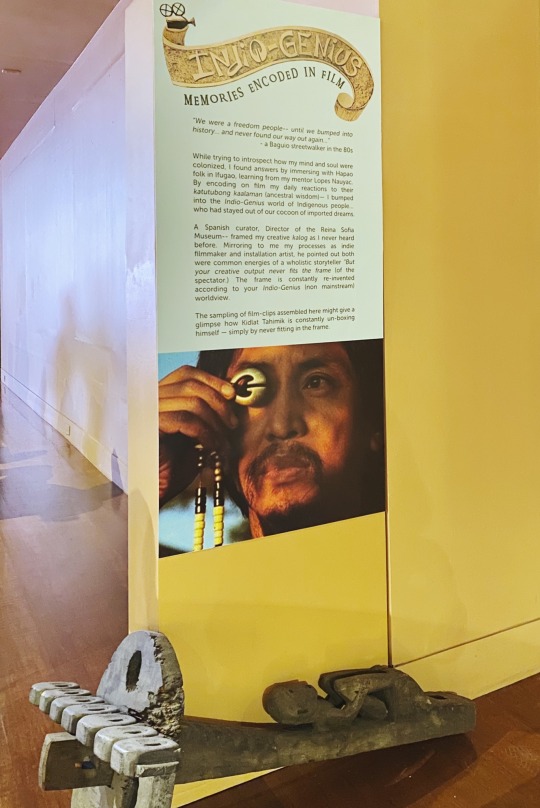

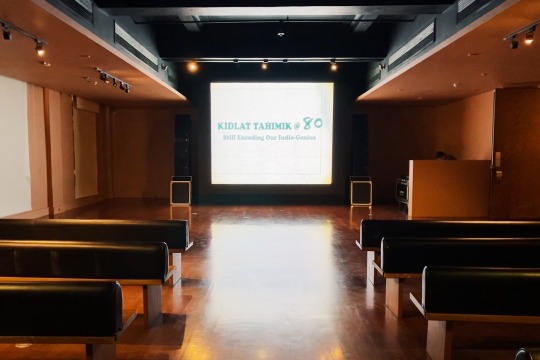





National Museum of Anthropology @natmuseumph (Manila) featuring the exhibit of National Artist for Film Kidlat Tahimik's, Indio-Genius: Memories Encoded in Film.
#nationalmuseumofanthropology #KidlatTahimik #indiogenius #filmexhibit #cinemaseries #film #cinemahouse #nationalheritagemonth2023
#National Museum of Anthropology#Kidlat Tahimik#Indio-Genius#Film exhibit#Cinema Series#Film#Cinemahouse#National Heritage Month 2023
2 notes
·
View notes
Text

A piece that has stuck with me that I saw in the National Museum of Anthropology (Museo Nacional de Antropología) in Mexico City.
1 note
·
View note
Text
For a belated #InternationalChessDay:

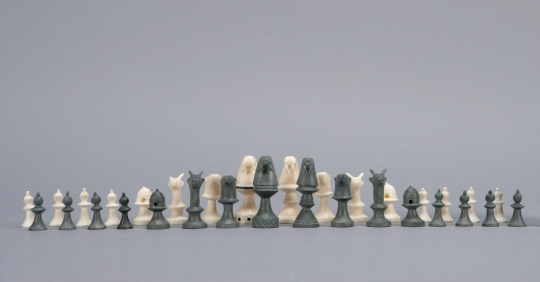
Chess set made by Inuit artist Pacome Qulaut, 1960
slate & walrus tusk
Museum of Anthropology
In each colour there are: 1 large walrus figure w/diamonds around base of pedestal (white piece has inlaid black stone in a band around top of pedestal & at centre of each diamond around base); 1 smaller walrus with bands around base of pedestal; 2 bears; 2 deer; 2 igloos; and 8 birds. All of the figures are at the top of a pedestal base.
#animals in art#Inuit art#Indigenous art#First Nations art#Native American art#Pacome Qulaut#modern art#20th century art#1960s#chess#chess set#game pieces#slate#walrus tusk#ivory#Museum of Anthropology#International Chess Day
186 notes
·
View notes
Text
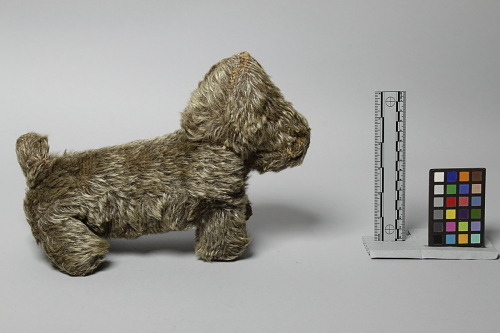
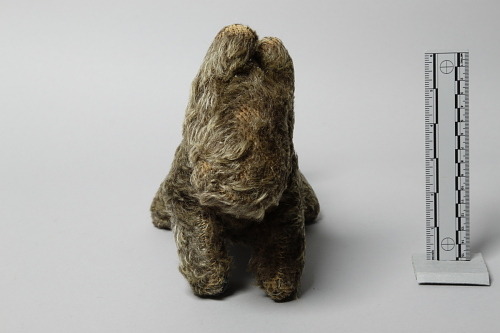
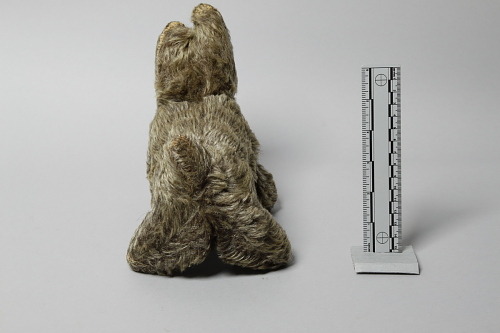
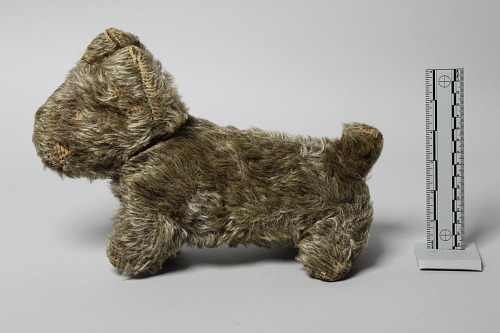
Scottie Dog stuffed animal
Stuffed plush animal toy, Scottie (Scottish Terrier) dog, made with synthetic shaggy "fur". Bron Solyom notes (page 6, see accession file): "These [toys, E434810-434817] were among Ann Dunham's personal possessions. I do not know if either of her children played with them." It is unknown when or where these were made or acquired.
Anthropology Collections
NMNH Research & Collections
#dogs#plush dogs#stuffed dogs#scottie dogs#plush scottie dogs#stuffed scottie dogs#cedric?#smithsonian institution#anthropology#national museum of natural history
66 notes
·
View notes
Text
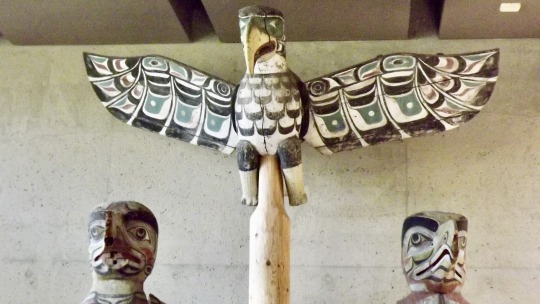
Eagle, Anthropology Museum, University of British Columbia, Vancouver, 2000.
#sculpture#eagle#northwest coast first nations#museum#anthropology museum#university of british columbia#vancouver#british columbia#2000#photographers on tumblr#pacific northwest#pnw
17 notes
·
View notes
Text


Tláloc pot . Ceramic pot modeled with a high-relief figurehead of the face of Tláloc, the god of rain. The Mexicas conceived it as made up of two snakes that intertwine themselves on the nose and gather together face to face with their heads where the mouth is located. In this case, said snakes can be appreciated through the bands with vertical lines and alternate circles that are found over his brows, eyes, and nose around the mouth.
It was located in the 21 offering of Templo Mayor and held on its inside various pearl shells and green stone beads. The latter being symbols of water. It belongs to the IV stage (1440-1469 d.c)

Offering 107 . This offering was located at the foot of the great platform of Templo Mayor and on its north side; that is to say, the corresponding one to the shrine of the god Tláloc. Its deposit took place during the VI stage of the building (1486-1502 d.c)
In this case, the Mexica priests arranged more than a thousand green stone beads that formed part of necklaces and that were found concentrated in three groups. This magnificent offering consists of two feline skeletons, one human skull belonging to an adult male individual, sea snails, flint knives, and silex as well as miniature obsidian knives
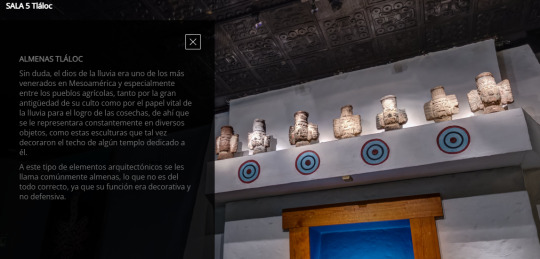
Tláloc almonds . Without a doubt, the god of rain was one of the most venerated in mesoamérica and especially around the agricultural-based towns. Both because of the great antiquity of its cult as well as for the vital role that rain had for the harvests, it is from there that it is represented constantly in different objects like these sculptures that may have decorated the ceiling of some temple dedicated to him.
These types of architectural elements are often times called almonds, which might not be entirely accurate as their function was decorative and not for defense.

Fragments of a Tláloc fire pit . This polychrome fire pit originally formed part of the basement of Templo Mayor. It presents the face of Tláloc with its characteristic paper headdress crowned with feathers, as well as a few symbols related to fire like the Xiuhtótotl ('turquoise bird') located in the front. The position of the hands is a feature of the Teotihuacan style that is added to the multiple Mexica reminiscences from that important cultural tradition.
It was elaborated with tezontle and decorated with ocher colors, red and blue, and applied over a base of white plaster. It was found in the back of Templo Mayor and belonged to the IV stage (1469-1481d.c)
(s. Museum of Templo Mayor, Mexico City)
#;ooc#ooc#;gallery#;t.laloc#/GODBLESS VIRTUAL TOURS OF MUSEUMS!!!!#I LOVE MUSEUMS!!! always have since i was but a lil lass#some parts have the printed text translated to english but some didn't or i couldn't see it but!!#i still wanted to share how cool this is!!!!!#there were other objects that had a relation to tlaloc in the other rooms that i might add to this post but#for now its this#also the second pic on the top; i think it was just a platform to display the pot but#the motif isnt uncommon and i remember seeing it on one of m.octezuma's palaces#u can see it too if u want!; theres another one im looking forward to seeing; the national museum of anthropology#i'll post about it when i look it up!
4 notes
·
View notes
Text
youtube
#artworld#exhibit#science#museums#artwork#technology#British Museum in London#England#Guggenheim Museum in Bilbao#Spain#National Museum of Anthropology in Mexico City#Mexico#Louvre Museum in Paris#France#Smithsonian National Air and Space Museum in Washington D.C.#USA#Youtube
0 notes
Text
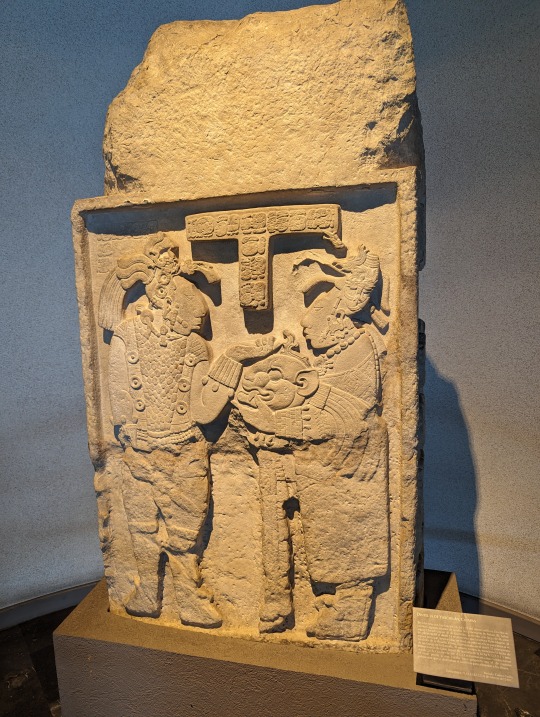
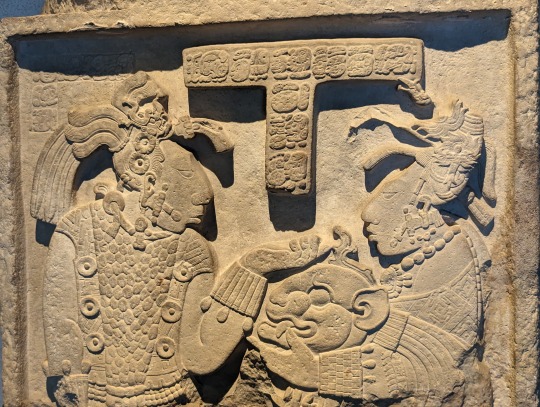
Stone Carveing of King Itzamnaaj Bahlam III from Chiapas, Mexico dated between the 7th and 8th Centuries on display at the National Museum of Anthropology in Mexico City, Mexico
King Itzamnaaj Bahlam III, Shield Jaguar, was king of Yaxchilan now in Chiapas in Mexico. Itzamnaaj was well known for commissioning new buildings and art for the city to promote his image and he reign. Itzamnaaj lived to being 95 and was recorded leading soldiers into battle at 85 though this is debatle and could be propoganda.
Photographs taken by myself 2024
#art#archaeology#history#fashion#maya#mayan#medieval#mexico#mexican#national museum of anthropology#mexico city#barbucomedie
27 notes
·
View notes
Text
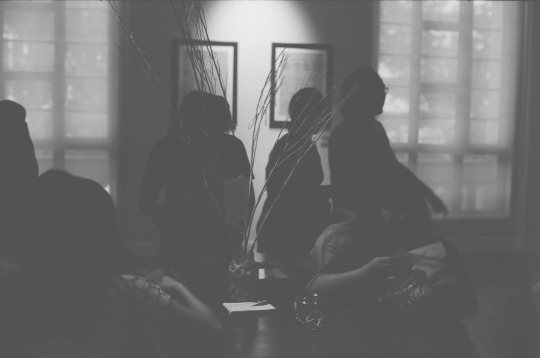





National Museum of Anthropology
Padre Burgos, Ermita, Manila 2019
Fujifilm Monochrome
#national museum#museum#anthropology#history#manila#philippines#35mm film#film photography#film#monochrome#black and white
1 note
·
View note
Text

[Image description: a clip of a headline that reads: Mexican history> Mexican government acquires long-lost Aztec manuscripts a out the rise and fall of Tenochtitlan]
The National Museum of Anthropology in Mexico City has announced the discovery of the Codices of San Andrés Tetepilco, three codices nearly 500 years old, telling the history of the city of Tenochtitlán. It includes details of life before and after European contact and conquest, written in a mix of Nahuatl, Spanish, and Indigenous Mesoamerican painting styles.
The indigenous people of Mexico and Central America, including civilizations before the Aztecs, had a very complete written history. However, most of these texts were burned by Spanish conquistadores, making findings like this very exciting.

[Image description: a page of the Codices of San Andrés Tetepilco, showing the inventory of a church on bark paper via imagery. It is faded and ripped in many places]
330 notes
·
View notes
Note
Hello! rly appreciating your posts, in particular the ones about GLAM... it made me curious if you or your followers happen to have any resources/literature to recommend on 2 areas of interest?:
1. Relating salvage anthropology to modern day ideas of trauma porn
2. Palestinian-led museums/archives/oral history projects/other collections or exhibitions of note. (Or if not literature, any names involved besides the few I know of like POHA/the nakba archive/the arab resource center for popular arts; the palestine museum; librarians & archivists with Palestine; activestills; forever our land; and art for gaza)
Anyway, again, thanks for all the time/work you’re putting into analysis and info dissemination <3
hello, thanks for sending this in. sooo i have like. no idea about the first one haha but i have so many for the second one.
The Institute for Palestine Studies has a bunch of scholarly articles and anaylsis about Palestine
Librarians and Archivists for Palestine is not completely Palestinian led but it's one that I'm a part of and really like, even though you already mention it.
The Palestine Museum Digital Archive is an AMAZING resource led by Palestinians in Palestine. I recommend scrolling through their intifada posters, downloading them, printing them, and hanging them around town.
The Palestinian Oral History Archive project in case people were wondering what POHA is.
The Museum of the Palestinian People in DC is really great and has a lot of digitized features.
The Palestine Museum US has a lot of books as well, based on Turtle Island.
The Arab American National Museum is not Palestinian led but I can vouch that they're a great group.
The Met has a lot of Palestinian clothing BUT.... warning in that it is very colonial in its arrangement and description and we dont super know how people got the material they have. If you want to look at the content feel free, though. Will say that Wafa Ghnaim, one of the leading experts on Tatreez in Turtle Island is working on recataloguing the Palestinian collection.
Visualizing Palestine is an infographic organization that might interest you.
The Nakba Archive for people wanting to check it out.
The Library of Congress is. Honestly it's pretty racist but it does have content if you wanna look at it.
Tirazain is a tatreez pattern library that's really cool.
There might be more that I'm forgetting but here are some just from me sitting here thinking for the past few minutes. If anyone else has any recommendations, feel free to add.
223 notes
·
View notes
Text
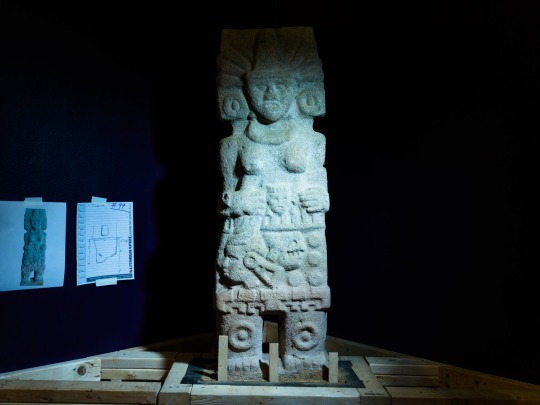
"The woman, carved in pale stone, wears a peaked headdress, circular earrings and the wide hip belt and kneepads of an ancient Mesoamerican athlete. Her expression is fierce, her pose triumphant. In her right hand, she grips the severed head of a sacrificial victim by the hair.
The sculpture is the first life-size representation of a ritual ballplayer found to date in the Huasteca, a tropical region spanning parts of several states along the Gulf Coast of Mexico.
Like virtually every other Mesoamerican society, the inhabitants of the Huasteca played what is simply known today as “the ballgame,” in the time before the Spanish conquest. Despite its name and ties to modern soccer, this game was more sacred rite than sport.
For the players, who bounce a solid, dangerously heavy rubber ball off their hips, it was a means of communing with the gods, one that sometimes culminated in human sacrifice.
The ballplayer will be among the most important artifacts in an exhibit, “Ancient Huasteca Women: Goddesses, Warriors and Governors,” at the National Museum of Mexican Art in Chicago, opening Friday. This is the first time the piece, which was discovered by landowners about 50 years ago near Álamo, Veracruz, has been on public display.
“It is a totally atypical sculpture,” said David Antonio Morales, an archaeologist with the National Institute of Anthropology and History in Veracruz, who stumbled upon it last November when he was visiting private collections.
He contacted María Eugenia Maldonado, one of the few archaeologists specializing in the pre-Columbian past of the Huasteca. At first, she didn’t think the figure could be real. It would be the first stone sculpture of a ballplayer found in the region, the first female ballplayer and the first at this scale holding a decapitated head.
“It’s putting all the elements into a single sculpture that had never been seen together before,” she said. “That is the importance of this sculpture.”
Kim N. Richter, a historian of pre-Columbian art at the Getty Research Institute in Los Angeles and an expert on female statues from the region, had not seen the piece. It “would be really important because we don’t have any monumental sculptures of ballplayers in the Huasteca to date, male or female,” she said. “So that would be a huge discovery in itself.”
Dr. Maldonado says she hopes the exhibition, with 100 artifacts, will challenge what she calls “superficial” interpretations of women’s roles that have riddled scholarship of the region. For decades, archaeologists have described sculptures of men as individuals in positions of power, like priests or rulers. They’ve tended to brush aside sculptures of women as images of a fertility goddess.""
#history#women in history#women's history#sportswomen#athletes#women in sports#mesoamerica#mesoamerican history#mexico#mexican history#huasteca#historyblr#historical figures#artefacts#sculptures#archeology
61 notes
·
View notes
Text

Stelae 1 and 3
Xochicalco
Late Classic (600-900 A.D.)
Xochicalco, State of Morelos
Volcanic tuff
Originally, approximately 1.50 m.
National Museum of Anthropology, Mexico.
518 notes
·
View notes
Text

Architectural element, Toltec, 950-1150 AD
from The National Museum of Anthropology, Mexico City
174 notes
·
View notes